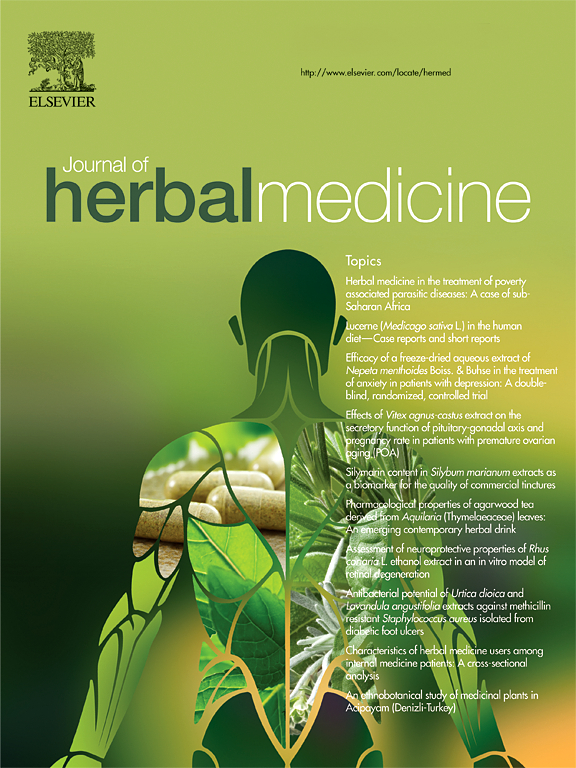阿尔及利亚和摩洛哥抗糖尿病药用植物的跨文化比较
IF 1.9
4区 医学
Q2 INTEGRATIVE & COMPLEMENTARY MEDICINE
引用次数: 0
摘要
糖尿病是一种全球关注的慢性内分泌疾病。本研究的目的是对阿尔及利亚和摩洛哥用于糖尿病管理的民族医学实践进行比较分析,为开发替代疗法和创新药物提供科学依据。方法将定量民族植物学研究的民族医学信息归一化。采用主成分分析(PCA)对区域数据进行比较,并辅以层次上升分类(HAC)来确定植物用途、植物部位和制备方法的相似性。结果阿尔及利亚共鉴定出68科225种,摩洛哥共鉴定出64科222种,其中两国共有95种(约占30%)。主成分分析显示阿尔及利亚和摩洛哥的区域间变异率分别为42.60%和43.43%。HAC根据植物用途、植物部位和制备方式将异构数据集细分为同质组。这些分组既反映了共同的民族医学遗产,也反映了特定区域的适应性,突出了植物治疗实践中冗余和差异之间的平衡,从而巩固了其稳定性和治疗多样性。结论民族植物学知识是一种动态的、有价值的资源,它超越了文化界限,为发现新的抗糖尿病配方提供了坚实的基础。共同框架和独特植物治疗特异性之间的微妙平衡支持了互补或协同疗法的发展。本文章由计算机程序翻译,如有差异,请以英文原文为准。
Cross-cultural comparison of antidiabetic medicinal plants used in Algeria and Morocco
Introduction
Diabetes is a chronic endocrine disease of global concern. The aim of this study is to provide a comparative analysis of ethnomedical practice used for diabetes management in Algeria and Morocco, offering a scientific basis for the development of alternative therapies and innovative drug discovery.
Methods
Ethnomedical information was normalised from quantitative ethnobotanical studies. Principal component analysis (PCA) was used to compare regional data, complemented by hierarchical ascending classification (HAC) to identify similarity in plant use, plant parts, and preparation methods.
Results
A total of 225 species (68 families) in Algeria and 222 species (64 families) in Morocco were identified, with 95 species common to both countries (around 30%). PCA revealed interregional variabilities of 42.60% (Algeria) and 43.43% (Morocco). HAC subdivided the heterogeneous dataset into homogeneous groups based on plant usage, plant parts, and preparation modes. These groupings reflect both a shared ethnomedicinal heritage and region-specific adaptations, highlighting the balance between redundancy and divergence within the phytotherapeutic practice, which underpins its stability and therapeutic diversity.
Conclusion
This study demonstrates that ethnobotanical knowledge is a dynamic and valuable resource, transcending cultural boundaries and providing a robust foundation for the discovery of novel antidiabetic formulations. The nuanced balance between common frameworks and unique phytotherapeutic specificities supports the development of complementary or synergistic therapies.
求助全文
通过发布文献求助,成功后即可免费获取论文全文。
去求助
来源期刊

Journal of Herbal Medicine
INTEGRATIVE & COMPLEMENTARY MEDICINE-
CiteScore
3.90
自引率
0.00%
发文量
94
期刊介绍:
The Journal of Herbal Medicine, the official journal of the National Institute of Medical Herbalists, is a peer reviewed journal which aims to serve its readers as an authoritative resource on the profession and practice of herbal medicine. The content areas of the journal reflect the interests of Medical Herbalists and other health professionals interested in the clinical and professional application of botanical medicines. The objective is to strengthen the research and educational base of herbal medicine with research papers in the form of case studies, original research articles and reviews, monographs, clinical trials and relevant in vitro studies. It also publishes policy statements, opinion pieces, book reviews, conference proceedings and profession related information such as pharmacovigilance reports providing an information source for not only the Herbal Practitioner but any Health professional with an interest in phytotherapy.
 求助内容:
求助内容: 应助结果提醒方式:
应助结果提醒方式:


